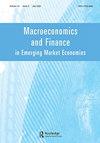Governance, regulation, incentives and outcomes
IF 1.1
Q3 ECONOMICS
Macroeconomics and Finance in Emerging Market Economies
Pub Date : 2023-09-02
DOI:10.1080/17520843.2023.2257431
引用次数: 0
Abstract
Under unprecedented global shocks emerging markets have held out relatively well. While growth slowed in the 2010s major emerging market (EM) financial or corporate crises were avoided. A key contributing factor has been improvements in institutions of governance. The research collected in this special edition explores many dimensions of this, covering governments, bank regulations and corporate governance. Better institutions create better incentives and lead to better outcomes. The papers’ rigorous evaluations in many different contexts and countries have lessons for other countries. And point towards new research to further our understanding of these important aspects. Global volatility has a cost and research in this area is critical to help risk-proofing in EMs. Most EMs implemented reform ideas available after the East Asian crisis since they had gained from openness and wanted to continue with it. But advanced economies (AEs) did not reform, leading inevitably to the global financial crisis (GFC) originating in AEs. The international financial system was also not reformed and EMs were left to manage alone large inflows in search of yield under zero AE interest rates and quantitative easing (QE) that followed the GFC. These quickly became outflows during periods of global risk-off. It is in the AEs interest to improve global safety nets since EMs now account for a large share of global growth. An earlier special issue in this area had looked at these risks and rewards of openness (Goyal, Sarkar, and Mallick 2012). The papers in this special issue explore the outcomes of specific governance measures EMs undertook. But risks evolve and continue. After the GFC major source AEs did tighten regulation for banks, where the crisis had originated with securitization failures. But they did not strengthen regulation for non-bank financial intermediaries (NBFIs), although influential macroeconomists recommended tighter universal macro-prudential regulations to accompany and mitigate risks from QE. As a result, cross border flows began to take place through NBFIs. Such arbitrage was only to be expected. EMs use macro-prudential tools more intensively compared to AEs. More AEs did start using such tools after the GFC, but AEs prudential regulation is largely limited to borrowers so that NBFIs’ risk-taking is not restrained (Goyal and Ray 2023). In AEs, loan-tovalue ratios to restrain consumer credit are the dominant measures used, in EMs it is FX position limits. Their prudential measures seem to have helped protect EM financial sectors so far. But under-regulation in AEs probably leads to over-regulation in EMs and reduces global welfare. Even for banks, the emphasis on self-regulation and own assessment of risks continued in AEs. The Trump government lightened regulations for small banks in 2018; they治理、监管、激励和结果
本文章由计算机程序翻译,如有差异,请以英文原文为准。
求助全文
约1分钟内获得全文
求助全文
来源期刊
CiteScore
2.40
自引率
7.70%
发文量
23

 求助内容:
求助内容: 应助结果提醒方式:
应助结果提醒方式:


